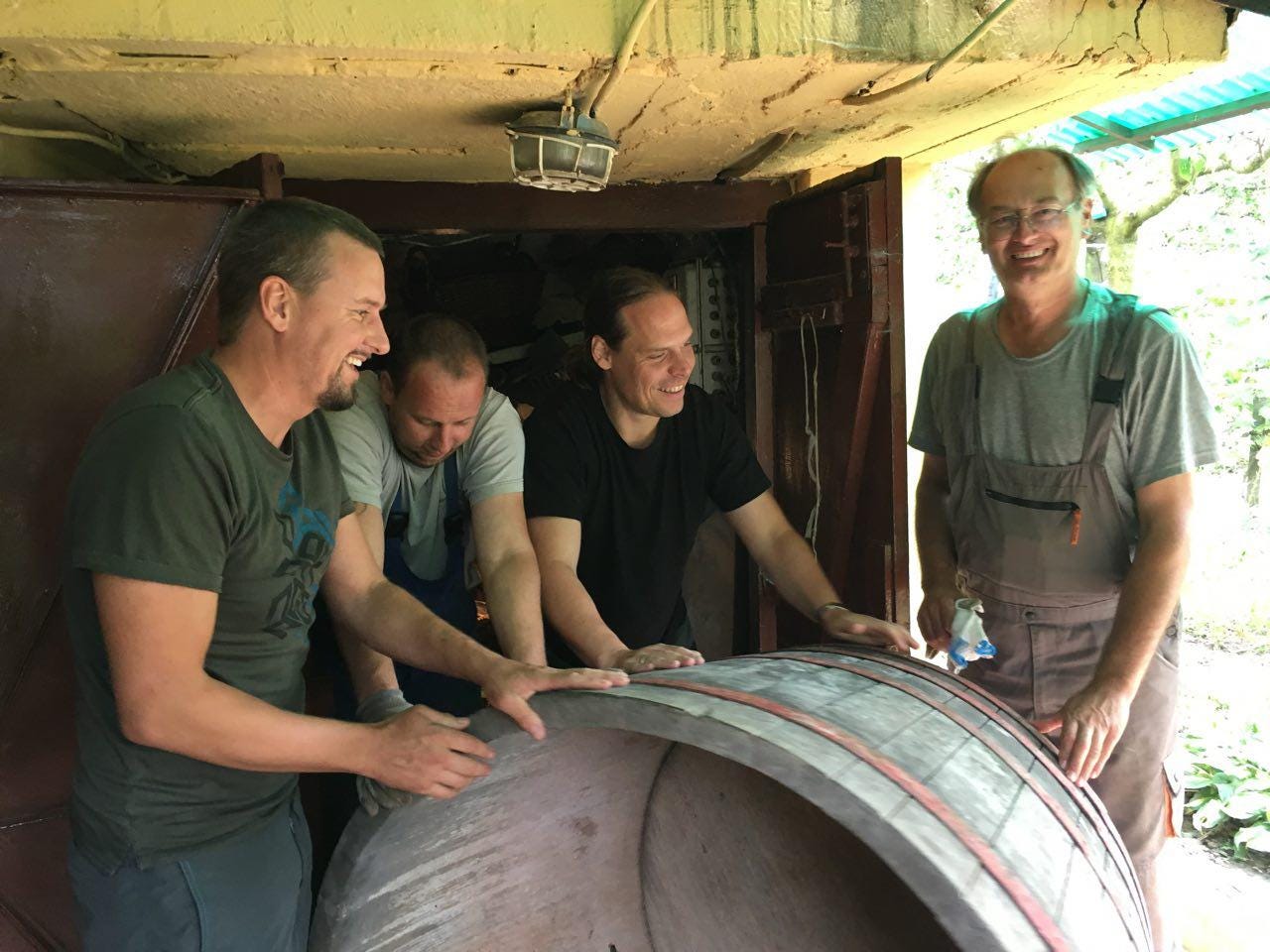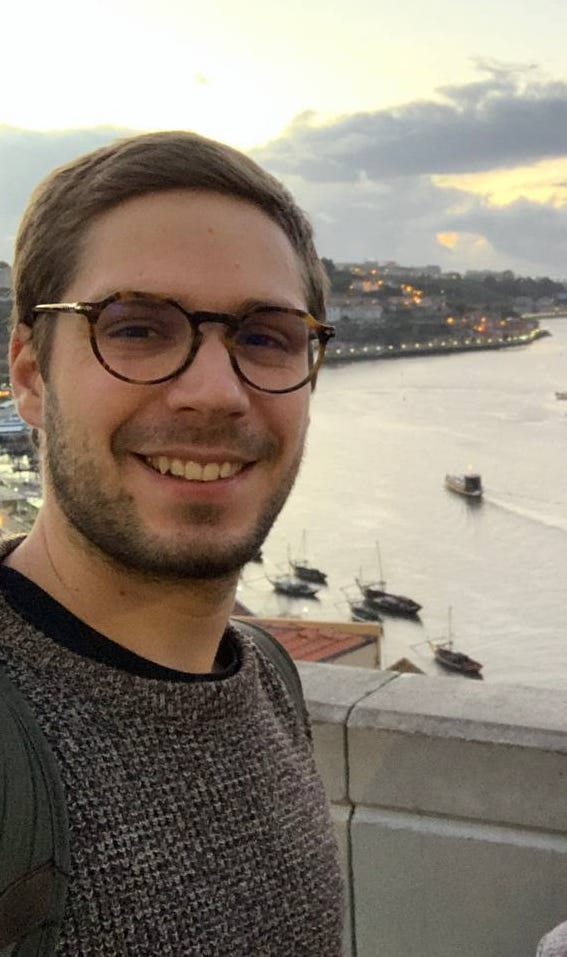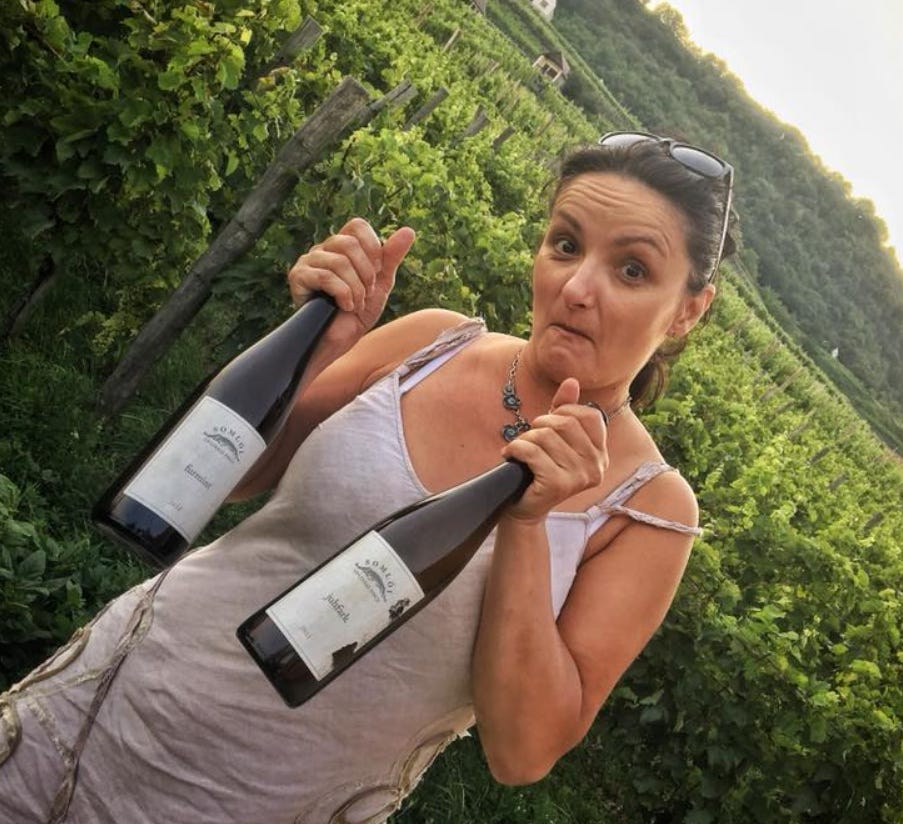Először is mindenkitől utólag is elnézést kérek. Én, ha a borászatunkról van szó, akkor nem szeretek bemutatkozni. Nincsen tele a fotómmal sem a weboldalunk, sem a Facebook-oldalunk. Szoktam és természetesen tudok is bemutatkozni, de nem szeretek. Ha valaki ellátogat hozzánk, akkor természetesen udvariasan be szoktam mutatkozni, ahogy arra a szüleim, nagyszüleim és tanáraim neveltek. Balogh Zoltán vagyok, a Somlói Apátsági Pince gazdája. De – ha nem is látszik – én már ettől zavarban vagyok.
Mert nem én vagyok a fontos, és nem is szeretek sem magamról, sem a családomról beszélni. Márpedig gyakran érzem, hogy ez lenne az elvárás. Egy olyan elvárás, aminek én nem tudok és nem is szeretnék megfelelni.
De hadd tegyek egy kis kitérőt. Magyarországon a modern magyar bor reneszánszának hajnalán, vagyis az 1990-es évek elején egy teljesen új kánont írt az a maroknyi bortermelő, aki berántotta a fél évszázados Csipkerózsika-álmát alvó privát magyar bortermelés motorját. Az állami gazdaságok mai szemmel erősen vitatható minőségű borait most ugorjuk át, ahogyan a hivatalosan piacra nem kerülő háztáji kispincék kannás kiszerelésű, bár olykor meglepően jó minőségű borait is.
A 90-es évek frissen, ropogósan induló lelkes borászatai és az akkori borsajtó egy teljesen új kánont írtak. Pont ahogy egyébként a rendszerváltás utáni piacgazdaság szereplői és a politikai, közéleti rendszerben is megpróbáltak Frankensteinként összerakni az 1945, vagy talán az 1921, vagy még inkább az 1914 előtti sablonokat a 20. század nyugat európájából a Trabant csomagtartójában Magyarországra csempészett eszköztárával. Így utólag némi keserű derűvel meg is jegyezném, hogy pont olyan is lett. De vissza a Csipkerózsika-álmából felébredt magyar bortermelésre.
A 90-es évek és később a 2000-es évek elejének boros közélete megteremtette a magyar borász sztereotípiáját. Jovális úriember (mindenképpen férfi!!!), lopóval a vállán valami pátoszos, misztikus, spirituális üzenetet előadva látja vendégül a borfogyasztót a borospince feletti lakásának a konyhájában vagy a teraszán, miközben a borász pirospozsgás felesége pogácsával, sajttal, házi sonkával, kolbásszal kínálja a vendégeket, akik péntektől vasárnapig, déltől másnap hajnalig kóstolják a gazda nedűit, és a végén beraknak pár karton bort a csomagtartóba. Ugyanez a recept kicsit megcsavarva még tartalmazhatja a borász kiskorú gyerekeinek a mókás bemutatóját, hogy milyen ügyesen tud bort lopni a hordóból, milyen frankón be tudja röccsinteni a TZ4K trakit az udvaron. A modern magyar bor reneszánszához ez a parasztromantikával átitatott, színes, szélesvásznú műsor elválaszthatatlanul hozzátartozott.
Ami ebbe a „magyar borász” arculatba nem fért bele, az a borászat városi befektetőinek a sora, akik 5-10 év után rájöttek, hogy soha nem fogják viszontlátni a pénzüket. Ahogy nem fértek bele a napszámosok százezrei, akik elvégezték azt a munkát, amiért a fogyasztók a borász vállát veregették. Ebbe a képbe nem fértek bele azoknak a borászfeleségeknek az ezrei, akik hajnalban feltakarították saját konyhájukat, teraszukat a vendégek után. A képben nincsenek benne a borászgyerekeknek az ezrei, akik hétvégenként aput csak mint a vendégeket alázatosan kiszolgáló és velük együtt kóstoló borászt látták.
Én úgy szoktam fogalmazni, hogy a 90-es években és a 2000-es évek elején kanonizálták Magyarországon azt a rendszert, hogy egy bortermelőtől elvárás, hogy a családját és a magánéletét beapportálja a cégébe. Elvárás lett, hogy a borász felesége és gyerekei ugyanúgy a borászat részei legyenek, mint a hordók, a szőlőtőkék és a lopó. A 2000-es évek marketinggéniuszai még meg is ideologizálták ezt a szerintem végtelenül toxikus, abuzív és családellenes rendszert azzal, hogy hát kell a sztori. Igen, kell, de nem így és nem ez.
Ha ismerünk egy frankó pékséget, akkor ott a sztori lehet az, hogy honnan szerzi be a lisztjét, milyen ezeréves kovásszal csinálja a kenyeret és hogy milyen távoli ország mestere építette neki a kemencéjét. Mesélje el a pék, hogy hol és hogyan inspirálódott, és mitől más az ő kenyere, mint másé. De ugye egy péktől nem várjuk el, hogy beengedjen a nappalijába, ahol beleülhetünk a fotelébe, és feltehetjük az asztalára a lábunkat? Ugye nem elvárás, hogy a pék felesége és gyerekei biodíszletek legyen? Nem sértődünk meg, ha a pék nem meséli el a gyerekkorát, és nem regél arról, hogy a pékségén kívül mivel tölti az idejét.
Ezt a felfogást pedig a Somlói Apátsági Pince egész csapata magáénak érzi.
Ja, ez a másik. Ugyanis a szőlészet és a borászat csapatmunka. Sajnos erről méltatlanul és igazságtalanul gyakran megfeledkeznek sokan. Persze, marketingszempontból szerencsésebb, ha egy név, egy arc köré lehet építeni egy márkát. De ha a marketingszempontok a hitelesség rovására mennének, akkor nem kérdés, hogy én melyik oldalon állok.
A lényegre térve, a Somlói Apátsági Pince sikerei és eredményei a csapatmunkának köszönhetőek, ahol a csapatban mindenki azon a poszton játszik, ahol a legjobb, és ahol a képességei a legjobban érvényesülni tudnak.
Mint már fentebb írtam, én lennék a gazda. Amit azt jelenti, hogy a Somlói Apátsági Pince szőlőterületeinek úgy 90% az enyém, a pince és a legnagyobb borház is az enyém, és a birtokon lévő további hat kisebb épületből ötnek a villanyszámlája is hozzám fut be. A csapatunk másik oszlopa Tamás, aki a birtok legmagasabb pontján lévő házát bütyköli, amikor nem Szegeden éli dolgos hétköznapjait. Ő a csapatunk leggyakorlatiasabb, legpragmatikusabb és legtürelmesebb tagja. Talán már húsz éve is megvan lassan, hogy egy ejtőernyős táborban összefutottunk, és azóta egy húron pendülünk. A nevünk miatt gyakran kérdezik tőlem, hogy testvérek vagyunk-e. Ő Balog, én pedig Balogh. De nem mindig oszlatjuk el az ilyen tévhiteket.
A csapat minden kétségen felül legfontosabb tagja pedig Fazekas Tibor, akivel már 2001 óta dolgozunk együtt. Ő a pannonhalmi időszak vincellérének, Fazekas Dénesnek az unokája, aki a szakmai kovásza a borászatunknak. Aki ismeri, az tudja, hogy nem egy szószátyár alkat, de amit mond, azt érdemes meghallgatni. Kevés hozzá hasonló helyben élő, tősgyökeres mesterember dolgozik manapság a Somlón.
Tibor jobbkeze és a csapatunk dolgos tagja Varga Zoli, aki nélkül nehezen kerülne palackba bor nálunk. Hozzá hasonló becsületes, egyenes és szorgalmas szakembert keresve sem lehet találni a környéken. Aki látogatóban járt már nálunk, az találkozhatott már Tibor leányával, Dórával, aki a papírmunkákból veszi ki a részét, és ott segít be, ahol éppen szükség van egy dolgos kézre.
Az elmúlt fél évtized során pedig Áron öcsém az, akivel talán a leggyakrabban találkozhattok a pince körül. Az elmúlt években nem értünk volna a szüretek végére nélküle. De mivel ő a csapat legfiatalabb és szerintem messze a legtársaságibb és legpörgősebb tagja, így egyre gyakrabban tartja ő a kóstolókat és fogadja a vendégeket, kereskedő partnereinket a birtokon.
Végül, de messze nem utolsósorban pedig – ha akarja ő, ha nem – én mindenképpen a csapatunk tagjaként mutatnám be azt a Cartwright Évát, akit a Somlón szerintem senkinek nem kell bemutatni. Azon túl, hogy a Somló hegy közösségének a kovásza ő, olyan még nem volt az elmúlt cirka tíz évben, hogy ha segítségre szorultam volna, akkor ne tett volna félre bármit, és ne jött volna segíteni. Akár ha marketing-, kommunikációs vagy logisztikai tanácsra szorultam, akár egy kóstolót kellett váratlanul megtartani, de amikor szüretnél megszorultunk, akkor is jött és segített. Nélküle egészen biztosan nem tartana ott sem a Somlói Apátsági Pince, sem pedig szerintem az egész Somlói borvidék, ahová eljutott.
Bónusznak pedig azért hozzávenném a felsoroláshoz a jogászunkat és a könyvelőnket. Aki vitt már vállalkozást Magyarországon, az tudja, hogy mennyire fontos az ő munkájuk.
Ez így vagy kilenc ember. Kilenc olyan ember, akiknek a munkája, segítsége, szaktudása, odaadása, figyelme nélkül nem tudnám elképzelni a Somlói Apátsági Pincét.
Amikor pedig azt érzem, hogy valaki nagyon egy személyre akarja kihegyezni egy borászat arculatát, akkor szerintem ez a 7-8 társam kerülne zárójelbe.
Lehet, hogy izgalmas kérdés, hogy mi is ezen 7-9 arcnak a története. Hogy ki hogyan is került kapcsolatba a Somlóval. Kit milyen erők húztak és tartottak a Hegyen. Alkalomadtán biztosan bármelyikünk szívesen elmondja. Nincsenek titkaink. De ezen történetek és beszélgetések helye a pince előtti diófa alatt van, egy pohár borral a kézben, és nem az újságok oldalain, nem a Facebookon és úgy általában nem az interneten. Mert egy dolog biztosan közös ebben a csapatban: nekünk a Somló a fontos, és az, hogy milyen bort is palackozunk mi a Somlón, és nem mi magunk. Mi csak úgy itt vagyunk és gondját viseljük a birtoknak néhány évtizedig. Már ha szerencsések vagyunk.
Finally, let me introduce ourselves
But not in the usual way. First of all, I would like to apologize to everyone in retrospect. When it comes to our winery, I really don't like to talk about myself. Our website and Facebook page are not filled with my photos. I can and of course do introduce myself, but I don't like it. If someone visits us, I naturally introduce myself politely, as my parents, grandparents, and teachers taught me. My name is Zoltán Balogh, the owner of the Somlói Apátsági Pince. But even though it may not seem like it, I'm already embarrassed by this. Because I'm not the important one and I don't like to talk about myself or my family. However, I often feel that this is the expectation. An expectation that I cannot and do not want to meet.
But let me make a little digression. At the dawn of the renaissance of modern Hungarian wine in the early 1990s, a handful of wine producers wrote a completely new canon by re-igniting the long stalled engine of the private (so not the crap made in Soviet style kolkhoz) wine production, which had been in a half-century-long Sleeping Beauty dream. Let's skip over the questionably high-quality wines of state-owned farms from today's perspective. The same goes for the wines of homestead cellars that are not officially released to the market, even though they are sometimes surprisingly good quality.
The enthusiastic wineries starting off in the 90s and the wine press of the time wrote a completely new canon. Just as the players in the newly born market economy and the political and public systems tried to Frankenstein together the pre-1945, or perhaps the pre-1921, or even more so the pre-1914 models with the model of the western Europe smuggled in the trunk of a Trabants into Hungary. Looking back, I would note that it turned out exactly what one would expect from such a weird combination. But let's get back to the Hungarian wine production that woke up from its Sleeping Beauty dream.
The wine culture of the 90s and early 2000s created the stereotype of the Hungarian winemaker. A jovial gentleman (definitely a man!!!), carrying a wine thief in his hand, delivers some mystical, spiritual message while entertaining wine drinkers in the kitchen or on the terrace of his home usually above or next to the wine cellar. Meanwhile, the winemaker's rosy-cheeked wife offers guests homemade scones, cheese, ham, sausage. They taste wines from Friday to Sunday, from noon until dawn, and then put a few cases of wine in their cars when they leave. This recipe might also include a funny demonstration by the winemaker's underage children showing how they cleverly steal wine from the barrel or how they expertly start up the TZ4K tractor in the yard. This colourful, wide-screen program, infused with peasant romanticism, was an integral part of the modern Hungarian wine renaissance. That was part of the business model.
What did not fit into this "Hungarian winemaker" image were the often urban investors who realized after 5-10 years that they would never see their money back. Also excluded were the hundreds of thousands of labourers who did the work for which wine drinkers praised only the winemaker. This image did not include the thousands of winemaker wives who cleaned their own kitchens and terraces after the guests left often after midnights. The image did not include the thousands of winemaker children who saw their father as a humble servant of his guests, serving them and tasting wines together with them on weekends. I let you figure out for yourself what in practice it means.
I usually phrase it this way: in the 1990s and early 2000s, a system was canonized in Hungary where it was expected that a winemaker would import their family and personal life into their company. It became an expectation that the winemaker's wife and children would be as much a part of the winery as the barrels, grapevines, and thieves. The marketing geniuses and the wine journalists of the 2000s even ideologized this, what I consider a toxic and abusive system, by saying that you need a story. Yes, you do, but not like this and not this way.
If we know a great bakery, then the story there could be about where they source their flour, how they make the bread with a thousand-year-old sourdough, and which master from a distant country built their oven. The baker can tell us where and how they got inspired and what makes their bread different from others. But we don't expect a baker to invite us into their living room where we can sit in their armchair and put our feet on their table, do we? We don't expect the baker's wife and children to be props, do we? We don't get offended if the baker doesn't tell us about their childhood or what they do outside of the bakery.
That is why at Somlói Apátsági Pince we draw the line between business and private life.
Oh, and there is one more thing. Wine making is a team effort. Unfortunately, many people unjustly forget this. Of course, from the marketing standpoint it is easier and often better to build a brand around a name and a face. But if marketing sacrifices credibility, then there's no question which side I'm on.
To get to the point, the successes of the Somlói Apátsági Pince are the result of a solid teamwork, where everyone plays in the position where they are the best and where their abilities can be best utilized to achieve the common goals. As I mentioned above, I am the owner, which means that I happen to own about 90% of the Somlói Apátsági Pince's vineyards, the cellar building and also five of the six smaller buildings on the estate. Another pillar of our team is Tamás, who owns the house on the highest point of the estate and when he is not on Somló he is busy in Szeged city. He is our team's most practical, pragmatic, and patient member. It has been almost twenty years since we met at a parachute camp and we have been on the same wavelength ever since. People often ask me if we are brothers because of our names ( he is Balog and I am Balogh). And often we let people assume that we are.
Without a doubt, the most important member of the team is Tibor Fazekas, with whom we have been working together since 2001. He is the grandson of Dénes Fazekas, the wine master of the Pannonhalma period. Tibor is the professional leaven of our winemaking. Those who know him know that he is not the man of the words, but it is worth listening to when he says something.
Tibor's right-hand man and our hardworking team member is Zoli Varga, without whom it would be difficult to put label even on our wines. One cannot find a honest, straightforward, and hardworking professional like him around Somló. If you have already visited us, you may have met Tibor's daughter, Dóra, who takes care of the paperwork and helps wherever there is a need for a busy hand.
In the past half-decade, my younger brother Áron (who opposed to Tamás is not even Balog but Lukács) has been the one you may have met most often around the cellar. In recent years, we would not have been able to finish the harvest without him. But since he is the youngest and, in my opinion, by far the most sociable and energetic member of the team, he is more and more often hosts tastings and welcomes guests and trading partners on the estate. Finally, but by no means least, if she allows it, I would definitely introduce Éva Cartwright as a member of our team, who, I think, needs no introduction on Somló. Beyond being the yeast and salt (and often pepper) of our Somló community, there has not been a single case the past ten years when she would not have put aside anything and not come if I needed help. Whether I needed marketing, communication, or logistics advice, or an unexpected tasting had to be hosted, she came and helped. She even joins us for a day or two when we are behind schedule during the harvest. Without her, the Somlói Apátsági Pince and, in my opinion, the entire Somló wine region would certainly not be where we are now.
As a bonus, I would add our lawyer and accountant to the list. Anyone who is running a business anywhere in the world knows how important their work is.
This is about nine people. Nine people whose work, help, expertise, dedication, and attention I could not imagine the Somlói Apátsági Pince without. However, when I feel that someone wants to focus the winery's image on just a single person, I feel like my 7-8 colleagues would be left out in the cold.
It may be an interesting question as to what the story is behind these 7-9 people. Who, how did they come into contact with Somló? Who or what forces pulled and kept them on the Hill? Occasionally, any one of us would be happy to share. We have no secrets. But the place for these stories and conversations is under the walnut tree in front of the cellar, with a glass of wine in hand, and not on the pages of newspapers, not on Facebook, and generally not on the internet.
Because one thing is for sure in this team, Somló is the most important to us, and what kind of wine we bottle at Somló, not ourselves. We as people are totally irrelevant in my view. The vines, the vineyard and the millions of years old volcano of Somló are what matter not us. We are just here for few decades. If we are lucky.






